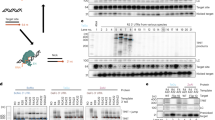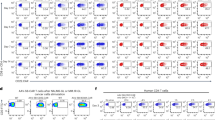Abstract
We have used a mobile mouse VL30 genetic element together with retroviral helper cells to efficiently transmit and express chimeric foreign gene sequences in murine and human cells. The construct comprised a cDNA copy of retrotransposon NVL3, an internal promoter [rat cytosolic phosphoenolpyruvate carboxykinase (PEPCK, EC 4.1.1.32)] and an expressed bacterial neomycin resistance gene. Thirty to sixty thousand colony forming units/ml (CFU/ml) were recovered from the supernatant of mass cultured psi2 helper cells transfected with the recombinant retro-transposon plasmid DNA. RNA was expressed from both the VL30 long terminal repeat and from the internal PEPCK promoter, resulting in a G418 drug resistance phenotype in recipient cells. Integrated VL30 DNA sequences transduced from psi2 or PAS 17 retroviral helper cells failed to regenerate detectable replication competent virus. Human and rodent recipient cells transduced by the retrotransposons appeared to bear intact vector sequences after two rounds of transmission by helper cells.
This is a preview of subscription content, access via your institution
Access options
Subscribe to this journal
Receive 12 print issues and online access
$209.00 per year
only $17.42 per issue
Buy this article
- Purchase on Springer Link
- Instant access to full article PDF
Prices may be subject to local taxes which are calculated during checkout
Similar content being viewed by others
References
Jaenisch, R. 1976. Germ line integration and Mendelian transmission of the exogenous Moloney leukemia virus. Proc. Nat. Acad. Sci. USA 73: 1260–1264.
Bosselman, R.A., Hsu, R.-Y., Boggs, T., Hu, S., Bruszewski, J., Ou, S., Kozar, L., Martin, F., Green, C., Jacobsen, F., Nicolson, M., Schultz, J.A., Semon, K.M., Rishell, W. and Stewart, G. 1989. Germline transmission of exogenous genes in the chicken. Science 243: 533–535.
Salter, D.W. and Crittenden, L.B. 1989. Artificial insertion of a dominant gene for resistance to avian leukosis virus into the germ line of the chicken. Theo. and App. Genet. 77: 457–461.
Gebhart, F. 1990. Firms pursue commercial genetic therapy. Genetic Engineering News 10(9): 1+45.
Temin, H. 1990. Safety considerations in somatic gene therapy of human disease with retrovirus vectors. Human Gene Therapy 1: 111–123.
Miller, A.D. and Buttimore, C. 1986. Redesign of retrovirus packaging cell lines to avoid recombination leading to helper virus production. Mol. Cell. Biol. 6: 2895–2902.
Miller, A.D. 1989. DNA constructs for packaging cell lines. United States Patent ♯4,861,719 (29 June, 1989).
Mann, R., Mulligan, R. and Baltimore, D. 1983. Construction of a retrovirus packaging mutant and its use to produce helper-free defective retrovirus. Cell 33: 153–159.
Mellor, J., Fulton, S.M., Dobson, M.J., Wilson, W., Kingsman, S.M. and Kingsman, A.J. 1985. A retrovirus-like strategy for expression of a fusion protein encoded by yeast transposon Tyl. Nature 313: 243–246.
Boeke, J.D., Xu, H. and Fink, G.R. 1988. A general method for the amplification of genes in yeast. Science 239: 280–282.
Rubin, G.M. and Spradling, A.C. 1987. Method of incorporating DNA into the genome of Drosophila; genetic engineering to cause sterility. United States Patent ♯4,670,388 (2 June, 1987).
Keshet, E., Shaul, Y., Kaminchik, J. and Aviv, H. 1980. Heterogeneity of “virus-like” genes encoding retrovirus-associated 30S RNA and their organization within the mouse genome. Cell 20: 431–439.
Hodgson, C.P., Elder, P.K., Ono, T., Foster, D.N. and Getz, M.J. Structure and expression of mouse VL30 genes. Mol. Cell. Biol. 3: 2221–2231.
Scolnick, E.M., Vass, W.C., Howk, R.S. and Duesberg, P.H. 1979. Defective retrovirus-like 30S RNA species of rat and mouse cells are infectious if packaged by type C helper virus. J. Virol. 29: 964–972.
Sherwin, S.A., Rapp, U.R., Benveniste, R.E., Sen, A. and Todaro, G.J. 1978. Rescue of endogenous 30S retroviral sequences from mouse cells by Baboon type C virus. J. Virol. 26: 257–264.
Foster, D.N., Schmidt, L.J., Hodgson, C.P., Moses, H.L. and Getz, M.J. 1982. Polyadenylated RNA complementary to a mouse retrovirus-like multigene family is rapidly and specifically induced by epidermal growth factor stimulation of quiescent cells. Proc. Natl. Acad. Sci. USA 79: 7317–7321.
Rodlund, K.D., Jue, S.F. and Magun, B.E. 1986. Regulation of VL30 gene expression by activators of protein kinase C. J. Biol. Chem. 261: 5029–5033.
Hatzoglou, M., Hodgson, C.P., Mularo, F. and Hanson, R.W. 1990. Transfer and expression of mouse VL30 retroelements in rat cells during infection with recombinant MoMLV viruses. Human Gene Therapy 1: 385–397.
Courtney, M.G., Schmidt, L.J. and Getz, M.J. 1982. Organization and expression of endogenous virus-like (VL30) DNA sequences in nontransformed and chemically transformed mouse embryo cells in culture. Cancer Res. 42: 569–576.
Carter, A.T., Norton, J.D. and Avery, R.J. 1983. A novel approach to cloning transcriptionally active retrovirus-like genetic elements from mouse cells. Nuc. Acids Res. 11: 6243–6254.
Adams, S.E., Rathjen, P.D., Stanway, C.A., Fulton, S.M., Malim, M.H., Wilson, W., Ogden, J., King, L., Kingsman, S.M. and Kingsman, A.J. 1988. Complete nucleotide sequence of a mouse VL30 retroelement. Mol. Cell. Biol. 8: 2989–2998.
Hodgson, C.P., Fisk, R.Z., Arora, P. and Chotani, M. 1990. Nucleotide sequence of mouse virus-like (VL30) retrotransposon BVL-1. Nuc. Acids Res. 18: 673.
Berk, A.J. and Sharp, P.A. 1977. Sizing and mapping of early adenovirus mRNAs by gel electrophoresis of S1 endonuclease digested hybrids. Cell 12: 721–725.
Ip, Y.T., Granner, D.K. and Chalkley, R. 1989. Hormonal regulation of phosphoenolpyruvate carboxykinase gene expression is mediated through modulation of an already disrupted chromatin structure. Mol. Cell. Biol. 9: 1289–1297.
Rasheed, S., Gardner, M.B. and Chan, E. 1976. Amphotropic host range of naturally occurring wild mouse leukemia viruses. Cancer. 33: 1027–1033.
Soule, H.D., Vasquez, J., Long, A., Albert, S. and Brennan, M. 1973. A human cell line from a pleural effusion derived from a breast carcinoma. J. Nat. Cancer Inst. 51: 1409–1416.
Goff, S., Traktman, P. and Baltimore, D. 1981. Isolation and properties of Moloney murine leukemia virus mutants: use of a rapid assay for release of virion reverse transcriptase. J. Virol. 38: 239–248.
Short, J.M., Wynshaw-Boris, A., Short, H.P. and Hanson, R.W. 1986. Characterization of the phospoenolpyruvate carboxykinase (GTP) promoter regulator region: II. Identification of cAMP and glucocorticoid regulatory domains. J. Biol. Chem. 21: 9721–9726
Coibere-Garapin, F., Horodniceanu, F., Kourilsky, P. and Garapin, A.-C. 1981. A new dominant hybrid selective marker for higher eukaryotic cells. J. Mol. Biol. 150: 1–14.
Cook, R.F., Cook, S.J., Savon, S., McGrane, M., Hartitz, M.D. and Hodgson, C.P. 1991. Expression of a chimeric gene containing the rat PEPCK promoter introduced into avian fibroblasts and chicken embryos using replication competent avian leukosis retroviral vectors. In preparation.
Graham, F.L. and van der Eb, A.J. 1973. A new technique for the assay of infectivity of human adenovirus 5 DNA. Virology 52: 456–467.
Ausubel, F.M., Brent, R., Kingston, R.E., Moore, D.D., Smith, J.-A., Seidman, J.-G. and Struhl, K. 1987. Current Protocols in Molecular Biology, John Wiley & Sons, New York.
Hodgson, C.P. and Fisk, R.Z. 1987. Hybridization probe size control: optimized oligolabelling. Nuc. Acids Res. 15: 6295.
Author information
Authors and Affiliations
Rights and permissions
About this article
Cite this article
Cook, R., Cook, S. & Hodgson, C. Retrotransposon Gene Engineering. Nat Biotechnol 9, 748–751 (1991). https://doi.org/10.1038/nbt0891-748
Received:
Accepted:
Issue Date:
DOI: https://doi.org/10.1038/nbt0891-748



